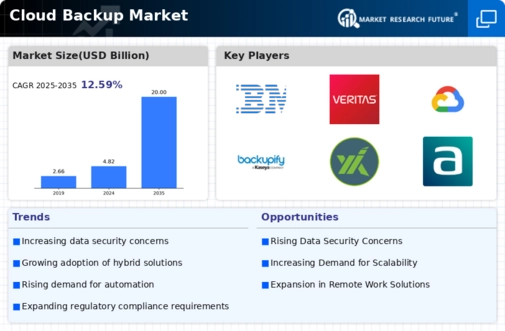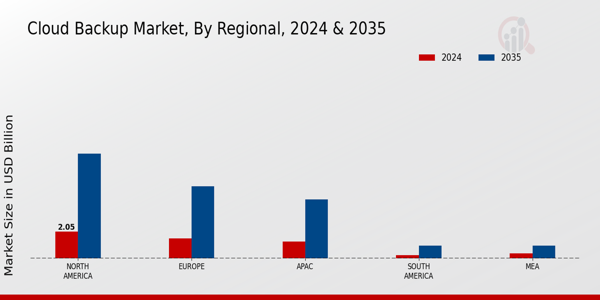Market Growth Projections
The Global Cloud Backup Market Industry is poised for substantial growth, with projections indicating a market value of 20 USD Billion by 2035. This anticipated expansion reflects the increasing reliance on cloud-based solutions for data management and protection. The compound annual growth rate of 13.81% from 2025 to 2035 suggests a robust demand for cloud backup services across various industries. Factors such as rising data generation, cybersecurity threats, and regulatory compliance are likely to drive this growth, making cloud backup an essential consideration for organizations aiming to safeguard their digital assets.
Increasing Data Generation
The exponential growth of data generation across various sectors is a primary driver of the Global Cloud Backup Market Industry. As organizations increasingly rely on digital platforms, the volume of data created is projected to reach unprecedented levels. This surge necessitates robust backup solutions to ensure data integrity and availability. For instance, in 2024, the market is valued at 4.82 USD Billion, reflecting the urgent need for effective data management strategies. Companies are compelled to adopt cloud backup solutions to safeguard their critical information, thereby propelling market growth.
Rising Cybersecurity Threats
The escalating frequency and sophistication of cyberattacks significantly influence the Global Cloud Backup Market Industry. Organizations face constant threats from ransomware, phishing, and other malicious activities, prompting them to prioritize data protection. Cloud backup solutions offer a reliable means to recover lost or compromised data, enhancing organizational resilience. As businesses recognize the potential financial and reputational damage from data breaches, investment in cloud backup services is likely to increase. This trend is expected to contribute to a market growth trajectory that could reach 20 USD Billion by 2035, highlighting the critical role of cybersecurity in driving cloud backup adoption.
Regulatory Compliance Requirements
Stringent regulatory frameworks governing data protection and privacy are pivotal in shaping the Global Cloud Backup Market Industry. Organizations must comply with various regulations, such as GDPR and HIPAA, which mandate secure data storage and backup practices. Failure to adhere to these regulations can result in severe penalties and reputational harm. Consequently, businesses are increasingly turning to cloud backup solutions to ensure compliance and mitigate risks. The growing emphasis on data governance is likely to drive market expansion, as organizations seek reliable backup solutions that align with regulatory requirements, further solidifying the industry's growth.
Cost-Effectiveness of Cloud Solutions
The cost advantages associated with cloud backup solutions are a significant factor driving the Global Cloud Backup Market Industry. Traditional backup methods often entail substantial capital expenditures for hardware and maintenance. In contrast, cloud solutions offer a pay-as-you-go model, allowing organizations to scale their backup needs according to demand. This flexibility is particularly appealing to small and medium-sized enterprises, which may lack the resources for extensive IT infrastructure. As the market evolves, the projected compound annual growth rate of 13.81% from 2025 to 2035 underscores the increasing adoption of cost-effective cloud backup solutions across various sectors.
Technological Advancements in Cloud Services
Rapid advancements in cloud technology are transforming the Global Cloud Backup Market Industry. Innovations such as artificial intelligence, machine learning, and automation are enhancing the efficiency and reliability of cloud backup solutions. These technologies enable organizations to optimize their backup processes, reduce downtime, and improve data recovery times. As businesses seek to leverage these advancements, the demand for sophisticated cloud backup solutions is expected to rise. This trend aligns with the broader digital transformation initiatives undertaken by organizations, positioning cloud backup as a critical component of modern IT strategies.




















Leave a Comment